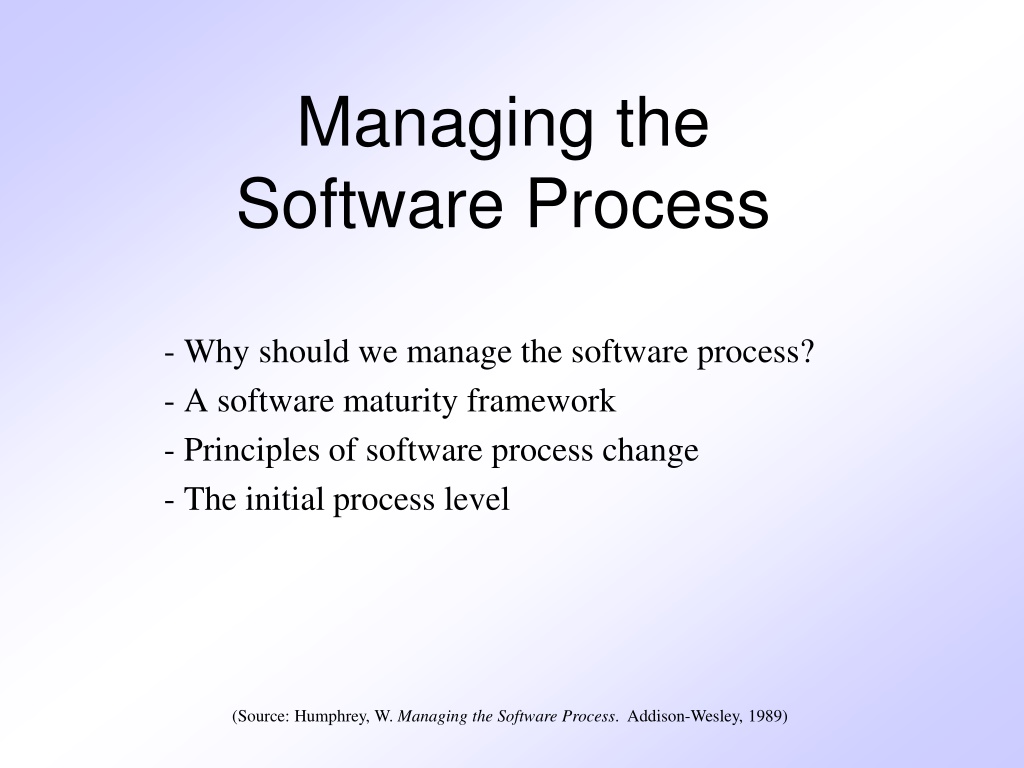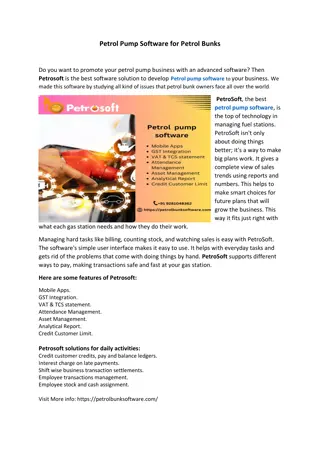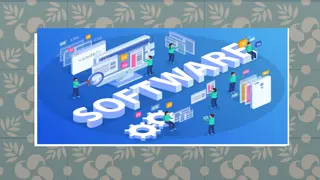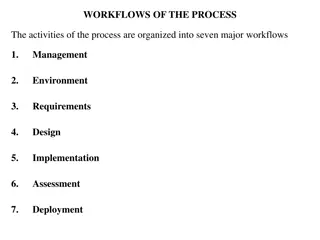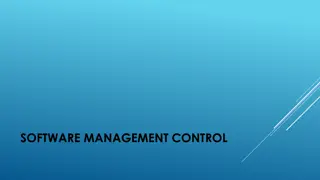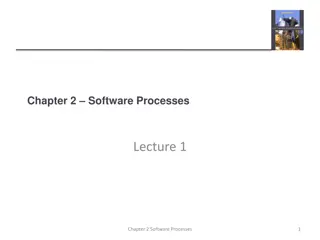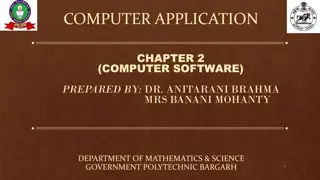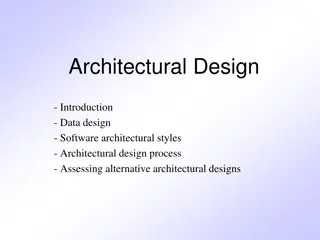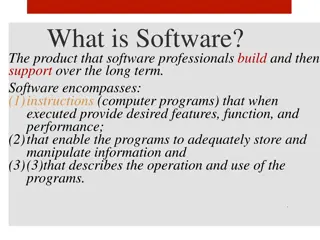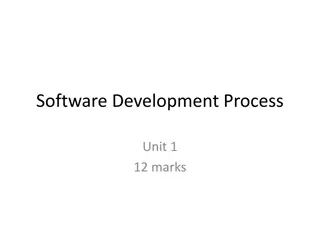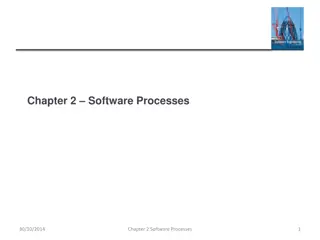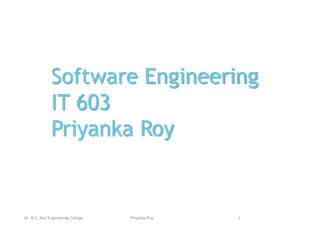Importance of Managing the Software Process
Efficient software process management is crucial for navigating the increasing scale of software projects and ensuring the productivity of talented individuals. By providing a structured and disciplined environment, organizations can support their teams in producing high-quality work. The myth of super programmers highlights the need for an orderly process framework to enhance software quality and productivity, even with top talent.
Download Presentation

Please find below an Image/Link to download the presentation.
The content on the website is provided AS IS for your information and personal use only. It may not be sold, licensed, or shared on other websites without obtaining consent from the author.If you encounter any issues during the download, it is possible that the publisher has removed the file from their server.
You are allowed to download the files provided on this website for personal or commercial use, subject to the condition that they are used lawfully. All files are the property of their respective owners.
The content on the website is provided AS IS for your information and personal use only. It may not be sold, licensed, or shared on other websites without obtaining consent from the author.
E N D
Presentation Transcript
Managing the Software Process - Why should we manage the software process? - A software maturity framework - Principles of software process change - The initial process level (Source: Humphrey, W. Managing the Software Process. Addison-Wesley, 1989)
IMPORTANT QUOTES "If you don't know where you are going, any road will do." Chinese Proverb "If you don t know where you are, a map won't help." Watts Humphrey "If you don't know where you are going, a map won't get you there any faster." Anonymous "You can't expect to be a functional employee in a dysfunctional environment" Watts Humphrey 2
Why Should We Manage the Software Process?
Individuals, Teams, and Armies History of software is one of increasing scale Initially a few people could craft small programs Today large projects require the coordinated work of many teams The increase in scale requires a more structured approach to software process management 4
People and the Software Process Talented people are the most important element in a software organization Successful organizations provide a structured and disciplined environment to do cooperative work Alternative Endless hours of repetitively solving technically trivial problems Time is consumed by mountains of uncontrolled detail If the details are not managed, the best people cannot be productive First class people need the support of an orderly process to do first- class work 5
Myth of the Super Programmers Common view: First-class people intuitively know how to do first- class work Implication: No orderly process framework is needed Conclusion: Organizations with the best people should not suffer from software quality and productivity problems However, studies show that companies with top graduates from leading universities are still plagued with the same problems New Conclusion: The best people need to be supported with an effectively managed software process 6
Myth of Tools and Technology Common View: Some technically advanced tool or method will provide a magic answer to the software crisis Reality: Technology is vital, but unthinking reliance on an undefined "silver bullet" will divert attention from the need for better process management 7
Major Concerns of Software Professionals Open-ended requirements Uncontrolled change Arbitrary schedules Insufficient test time Inadequate training Unmanaged system standards Very few even mention technology as a key problem 8
Limiting Factors in using Software Technology Poorly-defined process Inconsistent implementation Poor process management 9
Focusing on Software Process Management Software process: the set of actions required to efficiently transform a user's need into an effective software solution Many software organizations have trouble defining and controlling this process Even though this is where they have the greatest potential for improvement This is the focus of the book "Managing the Software Process" 10
Background Software process encompasses the set of tools, methods, and practices used to produce a software product Objectives (done simultaneously) Produce products according to plan Improve the organization's capability to produce better products Basic principles: Statistical process control and predictable performance The foundation of statistical control is measurement 12
Background (continued) "When you can measure what you are speaking about, and express it in numbers, you know something about it; but when you cannot measure it , when you cannot express it in numbers, your knowledge is of a meager and unsatisfactory kind; it may be the beginning of knowledge, but you have scarcely in your thoughts advanced to the stage of science." Lord Kelvin, a century ago 13
Software Process Improvement Steps 1) Understand the current status of your development process or processes Develop a vision of the desired process Establish a list of required process improvement actions in order of priority Produce a plan to accomplish the required actions Commit the resources to execute the plan Start over at Step #1 2) 3) 4) 5) 6) 14
Process Maturity Levels Level 1 Initial Level 2 Repeatable Level 3 Defined Level 4 Managed Level 5 - Optimizing 15
Level 1 - Initial Characteristics Chaotic planning, performance, and results Lost (i.e., forgotten) or misunderstood requirements Unpredictable cost, schedule, and quality performance Needed Actions Planning (size and cost estimates, schedules) Requirements and performance tracking Change control Management commitment Quality assurance 16
Level 2 - Repeatable Characteristics Intuitive Requirements and performance are tracked Cost and quality are highly variable Reasonable control of schedules Informal and ad hoc process methods and procedures Needed Actions Develop process standards and definitions Assign process resources Establish methods for requirements analysis, design, coding, inspection, and testing 17
Level 3 - Defined Characteristics Qualitative Requirements are logged, tracked, and closed out Reliable costs and schedules Improving but still unpredictable quality performance Needed Actions Establish process measurements Establish quantitative quality goals, plans, measurements, and tracking 18
Level 4 - Managed Characteristics Quantitative Reasonable statistical control over product quality Needed Actions Quantitative productivity plans and tracking Instrumented process environment Economically justified technology investments 19
Level 5 - Optimizing Characteristics Quantitative basis for continued capital investment in process automation and improvement Needed Actions Continued emphasis on process measurement and process methods for error prevention 20
A Perspective on the People Better people clearly do better work However, focusing only on talent can lead into a blind alley The best people are always in short supply You probably have the best team you can get right now With proper leadership and support, most people can do much better work than they are currently doing now 22
Basic Principles of Software Process Change Major changes to the software process must start at the top Ultimately, everyone must be involved Participators, Spectators, and Agitators Effective change requires a goal and knowledge of the current process Change is continuous Software process changes will not be retained without conscious effort and periodic reinforcement Software process improvement requires investment 23
Time, Skill, and Money to Improve the Software Process To improve the software process, someone must work at it Unplanned process improvement is wishful thinking Automation of a poorly defined process will produce poorly defined results (i.e., picking a solution before understanding the problem) Improvements should be made in small steps Train! Train! Train! 24
Common Misconceptions about the Software Process We must start with firm requirements Reality: Use an incremental software process If the software passes test, it must be OK Reality: Testing should strive to find errors, not prove they don't exist Software quality cannot be measured Reality: There exist many analysis and design metrics The problems are technical Reality: Immature organizations continue to make and remake the same management mistakes We need better people Reality: Most problems can only be fixed through management action Software management is different Reality: Yes at the micro level, but no at the macro level 25
A Strategy for Implementing Software Process Change Apply three phases: unfreeze, move, refreeze Unfreeze by identifying champions, sponsors, and agents Champions initiate the change process Sponsors are the senior managers Agents lead change planning and implementation Move by using key elements of effective change: planning, implementation, and communication Refreeze to ensure that an achieved capability is retained in general practice 26
Characteristics (revisited) Chaotic planning, performance, and results Lost (i.e., forgotten) or misunderstood requirements Unpredictable cost, schedule, and quality performance 28
What makes Software Organizations Chaotic? Unplanned commitments Schedules may show what is to be done but not an achievable plan to do the work Reliance on gurus Believe they can do no wrong When they fail, there is almost no way for the company to recover Belief in magic Humans are repelled by complexity so they try to make details seem so unnecessary that the hard work is deferred while Rome burns Problems of scale Having learned to build small programs, we falsely believe we are prepared to build large programs using the same skills 29
More on Problems of Scale As software products become larger, they are much more difficult to understand As software knowledge is more widely distributed, common notations are needed, the notations must be documented, conflicts in standards must be resolved, and standards must be controlled and distributed With larger-scale software, similar control is needed for requirements analysis, design, coding, and testing As software size increases, prototypes or multiple releases are needed With multiple releases, more complications arise concerning release schedules and other interdependencies 30
Steps toward a General Solution Apply systematic project management The work must be estimated, planned and managed Adhere to careful change management Changes must be controlled, including requirements, design, implementation, and test Utilize independent software quality assurance An independent technical team is required to assure that all essential project activities are properly performed 31
Summary for Controlling Chaos 1) 2) 3) 4) 5) 6) 7) Treat large systems as a collection of interdependent smaller ones Plan the work; divide the work into manageable tasks Precisely define the requirements and time for each task Identify and control the relationships/dependencies among tasks Commit to your assigned tasks and strive to meet them Track and maintain the plan Treat software development as a learning process and recognize what you don't know When the gap between your know-how and a task is severe, fix it before proceeding Manage, audit, and review the tasks in progress to ensure they are done as planned based on cost, schedule, and resource estimates 10) Refine the plan as your knowledge of the job improves and the project heads for completion 8) 9) 32
